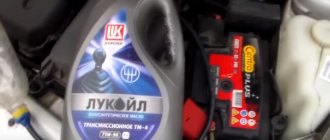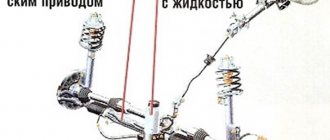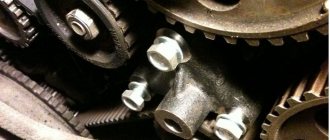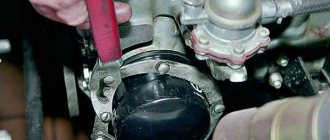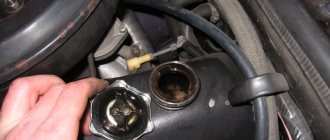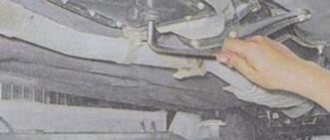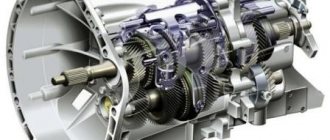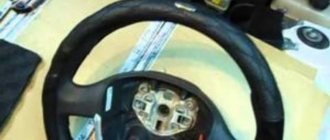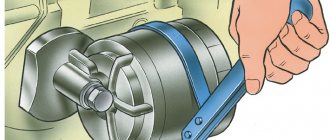How to bleed the power steering system on LADA cars
When you turn the steering wheel sharply, it jams (resistance increases), the power steering pump makes increased noise (hums or howls), and does the fluid in the power steering reservoir foam?
All these are signs of air getting into the power steering system. We'll tell you how to kick it out yourself. Air should also be removed from the power steering system after any work related to depressurization of the system (for example, replacing the power steering pump or pipelines).
Oil level in the power steering reservoir:
- on a cold engine should be no lower than o.
- with a warm engine - no higher than o.
Currently, the power steering system can be found on cars: Lada Priora, Largus, XRAY and Niva 4x4. In the first three cases, bleeding the power steering system is performed in the same way. On Lada 4×4 this process has distinctive features, but first things first.
How to change the power steering oil on a Lada Priora without going to a service station
Power steering (power steering) is found in almost any modern car. The power steering function is to facilitate steering turns by pumping oil at high pressure. Heavy-duty vehicles are especially dependent on power steering; without it, turning the huge wheels would be impossible.
Next we will talk about changing the oil in the power steering on a Lada Priora yourself. Experienced car owners know that this should be done at least once every 4-5 years (every 80 thousand kilometers). We have already considered replacing the VAZ 2115 power steering oil. There are no particular differences from a similar procedure on the Lada Priora.
Bleeding the power steering system on Lada XRAY, Largus, Priora
Start the engine and make several full turns of the steering wheel from one extreme position to the other. Then check the fluid level in the power steering reservoir. The difference between the level when the engine is running and the level after it is stopped should not be more than 5 mm. If the difference reaches 5 mm or more, then there is air in the power steering system.
How to remove air from the power steering system:
- Raise the front of the car (or the entire body) so that the front wheels do not touch the ground.
- Fill the power steering reservoir with working fluid until about.
- Rotate the steering wheel from side to side until it stops 5-6 times (the engine is not running).
- We rotate the steering wheel from side to side until it stops (without delays in extreme positions) 5-6 times (the engine is running, the speed is not higher than idle).
- Place the steering wheel in the middle position and turn off the engine.
- Check the fluid level in the power steering reservoir. If necessary, top it up to normal.
- Repeat the operation from 3-6 until the liquid level stops decreasing.
Bleeding the power steering system on VAZ 2121, 2131
Procedure:
- Add oil to the power steering reservoir to the lower mark.
- We start the engine and at idle speed, check the oil level in the tank. If necessary, top up to the lower mark.
- Turn the steering wheel left and right as far as it will go several times and check the oil level in the tank. If necessary, top up to the lower mark.
- Remove the protective cap from the bleeder fitting.
- We loosen the tightening of the bleeder fitting (key “8”).
- We connect a transparent hose to it, the other end of which is lowered into an empty container.
- Unscrew the fitting 1/2 turn.
- When a continuous flow of liquid without air bubbles appears in the hose, tighten the fitting.
- Set the steering wheel to the middle position and let the engine run for another 2-3 minutes.
- Turn the steering wheel left and right as far as it will go several times and check the oil level in the tank. If the level drops again, then repeat steps 4-9.
Let us remind you that you can look for other instructions for car repair and operation in the appropriate categories (Lada XRAY, Largus, Priora or Lada 4×4).
What kind of oil should I put in the Priora power steering?
What kind of oil to fill in power steering
It is not possible to fill the power steering with any oil. The difference between PSF and ATF is huge. The requirements for it are even greater than for the engine. It should be exclusively mineral water or synthetic, as well as a certain viscosity and properties.
From the factory, the Priora hydraulic booster is filled with light green oil Pentosin CHF 11S , the cost of which is more than 1,000 rubles per liter. Original article 00001-7504780-00-0 (price 1200 RUR). The manufacturer recommends using only original fluid for power steering , so the manual makes a note that using a fluid other than Pentosin Hydraulik Fluid CHF 11S-TL VW52137 may lead to malfunctions of the power steering pump!
We chose the synthetic gear oil “DEXRON III AUTOMATIC PLUS” from Mannol. Article number 1 liter bottle of power steering fluid - AP10107. The average market value is 390 rubles. It can also be liquid FEBI 6161 (price 500 rubles)
How much oil is in power steering Lada Priora
For a Priora with power steering, you will need an expansion tank
0.7 liters of liquid. When the system is completely pumped and flushed, the entire liter bottle can be used.
List of required tools
- Lift;
- 13 mm hex head ;
- The ratchet is large;
- Open-end wrench for 17, 22 and 27 mm ;
- Crosshead screwdriver;
- Sprocket T25 .
Communities › Lada Priora Club › Blog › Power steering, or why I don’t recommend it to anyone.
I wrote my blog the other day, and didn’t expect so many reviews and views. I decided to post it here. Because got into FAK and added pictures.
I was inspired to write a post by yesterday’s topic “Which is better power steering or power steering.” I paid a lot of attention to this when choosing a car. I even had to buy a car with air conditioning, overpaying 28 thousand rubles, just not to buy one with power steering. There is a lot of text, almost all of it is not mine, but a repost from the manufacturer’s website. The most interesting things are highlighted in bold italics. For those in a hurry, read only this. Once again I say that this is my opinion.
Steering Systems LLC is an organization that has been producing power steering for vehicles produced by JSC AVTOVAZ and JSC GM-AVTOVAZ for 12 years, in partnership with ZF Lenksysteme GmbH, one of the leading manufacturers of power steering.
Steering mechanism with built-in rack-and-pinion hydraulic booster Steering with hydraulic booster of the VAZ-2110 and VAZ-2170 Priora family of cars consists of the main components:
rack-and-pinion steering mechanism with built-in hydraulic booster; vane type oil pump; oil tank; high and low pressure hoses.
Power steering operating principle
The hydraulic booster operates on the principle of a piston in a hydraulic cylinder - the pressure of the working fluid developed by the pump pushes the piston, helping the driver turn the steered wheels of the car.
The main feature of the design is that the force developed by the hydraulic cylinder is proportional to the resistance force of the steered wheels to turn, i.e. helps the driver just enough to easily turn the steering wheel without losing track of the road. This feature is provided by a torsion-type switchgear built into the steering mechanism. The principle of operation of the amplifier is shown in the diagram (pictures). When driving in a straight line, the hydraulic booster practically does not participate in the work and does not affect fuel consumption, since when the wheels are rolling, the resistance force of the wheels to turn is insignificant, but thanks to the tracking action of the torsion bar (its angular rigidity is specially selected), the hydraulic booster is always ready for work. Advantages
The advantage of power steering is: The ease of driving while ensuring increased safety, primarily the absence of loss of directional stability of the vehicle in the event of a sudden failure (shot) of the tire of one of the front wheels. In damping return shocks, i.e. in smoothing out steering wheel jerks when hitting an obstacle. Increasing comfort when driving a car and reducing driver fatigue.
The main advantages of power steering:
“Steering feel” - feedback in the “driver-vehicle-road” system
Maintenance
As a rule, the power steering mechanism is highly reliable and does not require complex maintenance during vehicle operation.
Even if the power steering pump fails, you can continue driving the vehicle, although turning the steering wheel in this case will require significantly more effort than in a vehicle without power steering. The cause of complete failure of the hydraulic booster is most often a break in the pump drive belt. The condition of the belt should be checked regularly, because... it may be worn or loose. One of the signs of weak belt tension is the appearance of a kickback (reverse shock) on the steering wheel. This is usually most noticeable when the car starts moving with the wheels turned to full.
Changing the power steering oil on a Priora
Replacing the power steering on a Priora with your own hands is a mandatory operation for everyone. Power steering or power steering is a device that is now found in almost every car of both domestic and foreign origin. Thanks to it, less force is applied to the steering wheel, which makes driving absolutely safe. Therefore, many are beginning to be interested in the question of which power steering oil is better, how to replace the composition if necessary.
Location of the power steering on the Priora.
The design itself will be especially relevant for SUVs and large trucks. It also has several additional features:
- Allows you to drive your car even if the system is out of order.
- Softens the impact of the steering wheel on your hands when the road is uneven. Helps maintain control of the car, even if the front wheel has been torn off while driving.
- Makes the steering gear ratio much smaller. The car becomes less maneuverable, but more stable.
Over time, the hydraulic oil needs to be changed. This occurs when a leak occurs or according to the supplied instructions.
But many people believe that adding oil is not necessary, nor is changing it, because the car feels and behaves great on the road.
Experts still recommend carrying out this procedure approximately every 3 years of operation, or 50–60 thousand kilometers.
Replacing fluid in the power steering on a Priora
Welcome! Oil in the hydraulic power steering - thanks to it, the ease of rotation of the steering wheel is ensured (I mean thanks to the oil), but thanks to the hydraulic power steering itself, of course, it is easy to turn the steering wheel, but if there is no oil in it, then it will not work either, Therefore, you need to constantly monitor the oil level and be sure to change the oil itself from time to time, because it, like any other oil, does not last forever.
Note! In order to change the oil in the power steering, you will need to stock up on a set of tools, namely: We recommend that if you have two jacks, they are needed to lift both front wheels up and thereby the steering wheel will turn much easier, and the steering wheel you will have to turn for a very long time with the power steering not working, since when changing the oil it will not work for you, and you will also need to stock up on a medical syringe and a small long hose that you will put on this syringe, and you will also need a container into which you will drain used oil and, accordingly, a few unnecessary rags, in order to cover with them all the belts on which oil could presumably get on when draining the used fluid from the power steering reservoir!
Summary:
Where is the power steering reservoir located? In general, when changing the oil, you will use only this tank, because it contains the oil itself and you won’t even need to get to the other parts of the power steering, but the tank is located in the engine compartment of the car, so you will need to first open the hood and then find it (It is indicated in the photo below by an arrow).
When should you change the power steering oil? It is recommended to change the oil once every 2, or at least once every 3 years, during which time the oil already loses all its additives and in connection with this, extraneous noise may appear when the power steering is operating, and vibrations emitted by the power steering may also appear, and in general, you can’t drive on old oil (We’ll call it used oil) for a long time, because it loses its additives, and if it loses its additives, then its purpose is to protect the bellows from breakdowns and because of this the mechanism will fail much faster.
Note! Don’t always look at how long the car has run on new oil, or how many years have passed since the last fill, it’s better to check everything yourself, regardless of the numbers, to do this, unscrew the top cap of the tank (It is also indicated by the arrow), and after it you will be turned out, look at the oil itself, if it is darkened and there is also a burning smell to all this, then this oil must be changed to a new one without delay!
Tools
The following tools will be needed.
- You can't do without a few rags.
- A plastic vessel with a volume of at least a liter.
- A syringe, a large rubber bulb.
- Ten socket wrench.
- Pliers.
A 20 ml syringe connected to a piece of plastic straw is great for pumping oil out of the reservoir.
Algorithm for replacing power steering fluid Lada Priora
- Raise the front end with jacks (this will make it easier to drain the old oil)
- Use a syringe with a hose of the required diameter (you can use a washer hose) to pump out the oil from the tank.
Operating procedure
Before starting work, you need to prepare a container where the oil will drain. Castrol is no exception.
- Jack up the front wheels. Two tools should be enough for this. The procedure will be especially useful when you have to drain the old composition.
- A bulb or syringe will help rid the structure of old liquid. The oil tank becomes one of the most important parts.
- It is necessary to cover the belts with something. This will protect them from the oil, otherwise it will be difficult to get rid of the marks later.
- You need to call an assistant so that he can twist the steering wheel as much as possible, either to the right or to the left. Oil will appear in the tank again, which must be pumped out immediately.
- The return hose is turned off. It doesn't matter if you use Hadot oil, Eneos oil or something else.
- The hose is lowered into the bottle, after which the old excess liquid is drained again.
- You can connect the hose back when everything is completely drained.
- A new composition is poured in until the Lada Priora part is completely filled. The frequency of replacement has already been described previously.
- Again you need to ask someone to turn the steering wheel. Oil is added to the system as it drains.
- The specification says that you need to start the engine for 10-15 seconds after the work has been completed. The liquid will begin to decrease again. And again topping up is required.
- It remains to make sure that when turning the steering wheel no air bubbles appear in the tank. Power steering always requires such checks.
- If necessary, add oil to the appropriate level.
Power steering oil change process.
After all the steps have been completed, you need to start the engine and turn the steering wheel to the side. Factory oil should not cause any problems. The presence of hum is also unacceptable. The rotation should be very smooth, without any problems.
Interchangeability and classification of oils
Typically, oils are divided into several types depending on color. How often to change the oil has already been described. The classification by color is not entirely correct. And don’t think that you can mix different brands of oils, even if they have exactly the same color. The composition and viscosity can always be different.
Power steering oils vary and have different features depending on the color.
There are some features associated with the color of the oil that are worth considering in more detail.
- Green color. This family is mainly used in VAG, Citroen, and Peugeot cars. The main thing is to never mix mineral water with synthetics if they have this color. Automatic transmission oil is never suitable.
- Mercedes cars use a yellow grade of oil.
- Dexrons are red. Only for automatic transmissions.
Changing the oil in the power steering of Priora
You will need : two jacks, a syringe, a piece of glass washer tube, an empty container, a clamp and a Phillips screwdriver. Close the belt to prevent oil from getting on it.
Mixing system
Red and yellow oils can be mixed with each other only if they belong to the same group - synthetic or mineral. But mixing greens is only allowed with their own kind.
If you add green oil to yellow oil, foam may form. Then it is necessary to flush the system before using oil with a different color.
No foreign phenomena are observed when yellow power steering oils and mineral Dexrons are mixed. In the new composition, such additives continue to function normally.
You can add, for example, conditionally miscible oils. Only from different manufacturers, and the mixing itself occurs in different ways. The service life of the hydraulic booster does not change, as does the main operating mode.
There are also oils that can only be mixed with each other. They can be used instead of other compounds if you first clean the entire system.
Bleeding power steering in a car
Bleeding the power steering and its entire system is a special procedure, which is usually carried out when airing occurs as a result of any malfunction, as well as when replacing the working fluid. If air gets inside the power steering, then there is a decrease in the efficiency of the power steering and leads to its breakdown. In this case, bleeding is the best option to restore the normal functioning of the entire system. The procedure must be carried out very carefully, strictly observing special technology.
How to bleed the power steering with your own hands: simple instructions
Hi all! The article was created specifically for owners of cars with power steering and those who plan to make a corresponding purchase in the future. We’ll talk to you about how to bleed the power steering, what is required for this and whether it is possible to do the work yourself.
Practice clearly shows that pumping is done in cases where the working fluid is being replaced, when signs of air congestion and malfunctions are detected. Typically, such a need arises as a result of breakdowns or after standard repair work affecting the power steering system. For example, bleeding is often carried out after replacing the rack.
If you do not expel the air that has entered the system, this will lead to a decrease in the efficiency of the hydraulic booster and provoke further malfunctions. In particular, you may encounter the fact that the pump will need to be replaced, and there will be no way to restore it.
Signs of faults in the power steering
Before bleeding the power steering, you need to check the equipment for malfunctions, signs of which include the following violations:
- While the car is moving, quite a lot of noise occurs, which is observed in the area where the power steering system is located, as well as its pump;
- The pressure on the steering wheel increases noticeably, as a result of which it becomes difficult to turn it when steering;
- Working fluid may leak from the power steering system;
- A fairly thick layer of foam forms on the surface of the working fluid contained in the expansion tank;
- When the vehicle is moving, spontaneous turns of the steering wheel in different directions may occur.
Typical power steering malfunctions
Malfunctions in the operation of the hydraulic booster can be easily identified by characteristic signs. Among them:
- The steering wheel turns hard . Probable causes are failure of the power steering pump, use of unsuitable working fluid, sticking of the spool mechanism channels.
- , a high-frequency sound (similar to a whistle) is heard while driving The probable cause is a loose drive belt.
- The steering wheel turns jerkily . Probable causes of the malfunction are the working fluid not meeting the specifications declared by the manufacturer, a malfunction of the fluid distributing mechanism, or a pump malfunction.
- The presence of intense foaming in the expansion tank. Probable causes are mixing of different types of fluids, failure of the power steering pump.
- When the engine is running, the steering wheel spontaneously turns in any direction . The probable cause is malfunction of the spool mechanism, most often, clogging of its working channels, incorrect assembly (for example, after installing a repair kit).
Recommendations for operation and maintenance of power steering
In order for the power steering and its system to operate normally, as well as to extend their service life, you must adhere to several simple rules:
- use working fluids recommended by the automaker , and also replace them in a timely manner (most automakers recommend replacing power steering fluid every 60.120 thousand kilometers, or once every 2 years, it depends on the driving style and intensity of use of the car);
- carry out bleeding of the power steering system in strict accordance with the algorithm described above (or observing individual requirements, if any are set by the car manufacturer);
- monitor the condition of the steering rack boot , because if it is torn, dust and dirt will enter the system, which leads to the power steering pump exiting. A sign of a problem that has already occurred is the hum of the power steering, which is not eliminated even by replacing the fluid.
Cost of replacing fluid and pumping power steering
If you plan to carry out work on replacing the fluid and pumping the power steering yourself, then you will only need to buy oil in a volume of 1 to 3 liters (including flushing, while the volume of the power steering system of a passenger car is up to 1 liter). The price of the liquid depends on the brand and store. It is within $4.15 per liter. If you do not want or cannot carry out such work yourself, contact a service station for help. Approximate prices for January 2021 are:
- fluid replacement work - 1200 rubles;
- power steering pumping - 600 rubles.
How to bleed power steering?
When bleeding this vehicle mechanism, you must fully follow all the rules of the procedure:
- First of all, you should completely raise the car using lifts or by hanging the front wheels of the vehicle;
- If necessary, you need to completely drain the already used old fluid contained in the expansion tank. To do this, you need to remove the return hose, attach a plug to it so that the substance does not spill out of it, then a hose is connected to the released valve on the equipment, through which the working fluid is drained into the prepared container;
- Experienced experts recommend draining the main volume of working fluid using a syringe, pouring it into a regular bottle - this is more convenient;
- Once there is a very small amount of liquid in the expansion tank, you can proceed to the next step - fill the container to the very top with new working fluid;
- The steering wheel rotates from one side to the other, bringing it all the way to the stop. This should be repeated several times, allowing all the old fluid to drain completely through the hose. Due to the fact that the new substance actively displaces the old one, during the procedure it is necessary to control the oil level in the expansion tank, because air should not penetrate into it;
- As soon as the fluid level begins to drop, it should be added;
- The next step is to turn on the engine for a few seconds, then turn off. Thus, it is possible to start the process of spreading hydraulic fluid throughout the entire mechanism;
- Next, the solution is added to the tank until its level reaches the MAX mark, then the operation is repeated to start the vehicle engine. This cycle should be repeated approximately five times;
- You can stop pumping only after the drain bottle stops filling with air, which will be supplied from the return hose. Only after this can you understand that the tank will begin to fill with new and clean hydraulic fluid;
- Then the return hose is installed in its original place;
- The expansion tank is filled back up to the MAX mark, and then the engine starts again;
- To completely complete pumping the power steering, you need to slowly turn the steering wheel from one stop to the other five times until the very end. As soon as the steering wheel reaches both the left and right stops, it is necessary to pause for several seconds. Thanks to this, the air can completely escape from the system into the expansion tank. In addition, you need to ensure that no extraneous noise arises during operation;
- If foam and air bubbles do not form on the surface of the liquid in the tank, then you can stop the procedure;
- After pumping is completed, the tank must be tightly screwed on with the lid.
We pump the power steering with our own hands
It is necessary to change the working fluid and pump the power steering system in strict accordance with the regulations and the established algorithm.
However, there are exceptions when automakers adjust the pumping process, trying to make it more convenient and simpler. With the instruction manual at hand, be sure to look at the correct section. There you will find everything you need related to the hydraulic booster installed specifically on your vehicle. Due to the introduction of some features of each car manufacturer and power steering systems, a universal pumping scheme cannot actually exist. There are several common points that are characteristic of all hydraulic boosters.
It is on them that I propose to place the main emphasis. This will give you the opportunity to understand what to do and what to build on when planning to bleed the power steering on your own car.
Initially, you will need appropriate conditions where you can lift the car completely or hang the front wheels. If necessary, the old fluid is drained from the expansion tank. To do this, remove the return hose from the tank and insert a plug into it. This will prevent hydraulic fluid from spilling out.
Having released one of the taps on the tank, a hose connected to an empty plastic bottle is connected to it. It is there that the hydraulic mixture from the power steering system will subsequently be drained. This is the simplest and most common scheme.
To make it easier for you to pump out the bulk of the old fluid, you can use a syringe. As soon as a minimum volume of hydraulics remains in the reservoir, which can no longer be pumped out with this device, you can move on to the next stage. Namely, fill in new fluid to the upper mark on the expansion tank. After this, be sure to turn the front wheels in different directions and strictly until they stop. This will allow any remaining old fluid to drain out through the connected hose.
Please note that the new hydraulic oil will now displace the old one. Monitor the level carefully and try not to allow air to enter the system through the hose.
Further actions
We have already managed to cover about half the distance together. As you can see, nothing complicated yet. Everything can be done with your own hands, without having any special skills or deep knowledge.
After completing all the previous steps, follow these steps:
see also
Insulating a car for the winter: what you can do yourself
- if the liquid level in the expansion tank has dropped, add oil;
- start the engine for literally 3 seconds and turn it off;
- the liquid will begin to spread throughout the system;
- add oil to the MAX mark and repeat the procedure with the internal combustion engine;
- such a cycle usually requires 3-5 repetitions;
- you need to stop pumping when air stops escaping into the drain bottle;
- if clean hydraulics without bubbles enter the container, there is no air left in the system;
- return the return hose to its place;
- if necessary, add oil to the maximum mark;
- start the engine;
- slowly turn the steering wheel left and right until it stops 4-5 times;
- Having turned the steering wheel all the way, stop for 2-3 seconds and turn in the opposite direction;
- if there is remaining air, it will enter the expansion tank;
- Make sure that the power steering pump does not create any extraneous noise when pumping;
- as soon as air bubbles stop appearing on the surface of the power steering fluid in the tank, pumping is completed;
- Screw the reservoir cap tightly.
There is an alternative bleeding method that does not involve starting the engine. In this case, you just need to turn the steering wheel all the way to the left and right.
But increasingly, automakers are abandoning this scheme due to the low efficiency of the pumping procedure.
see also
Trunk volume on Kia Sportage crossovers of different generations
It is optimal if, upon completion of the procedure, the oil in the power steering expansion tank is between MIN and MAX. This is due to the property of a liquid to expand when heated. Therefore, it is not recommended to fill the oil all the way.
Recommendations for further use
Bleeding the power steering helps restore vehicle performance.
However, in order to maintain the results obtained for a sufficiently long period of time, you need to follow several general rules:
- It is better to use a high-quality working fluid that is recommended by the automaker;
- It is necessary to timely replace the hydraulic fluid in the power steering system;
- When pumping, you should strictly follow the instructions;
- Constant monitoring of the condition and operation of the steering rack boot is required, regularly cleaning it from dirt and dust.
Bleeding the power steering is an indispensable procedure that is required to maintain the normal operation of the car and the good condition of the entire system. Therefore, you should not neglect its implementation, because otherwise, various vehicle breakdowns may occur that require serious repairs.
see also
Characteristics of Dextron 2 and 3 - what are the differences
- 38 1 29k
Power steering malfunctions
- 22 0 33k
What kind of oil to fill in power steering
- 160 0 214k
Power steering buzzes
- 360 7 331k
15 best power steering fluids
- 122 13 371k
Bleeding the power steering and its system is carried out when replacing the working fluid, airing, which may be the result of a malfunction or repair work. Air trapped inside not only reduces the efficiency of the power steering, but can also cause serious damage, in particular, failure of the power steering pump. Therefore, pumping the hydraulic booster must be carried out in strict accordance with existing technology.
